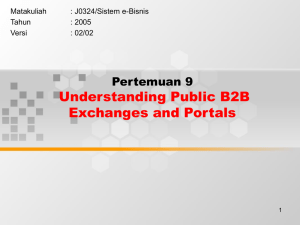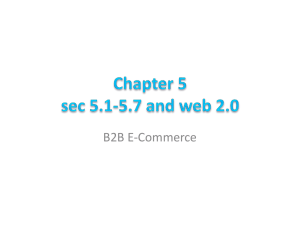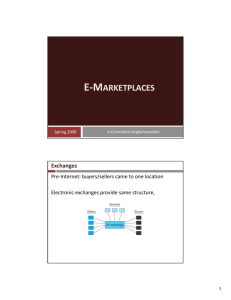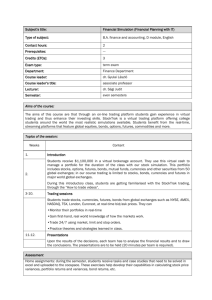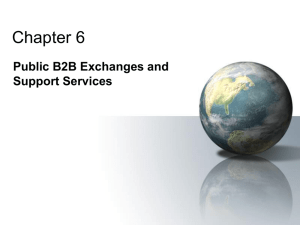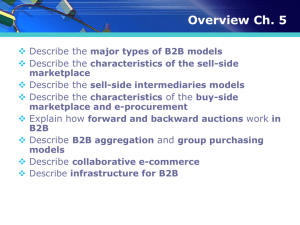B2B portals - Binus Repository
advertisement
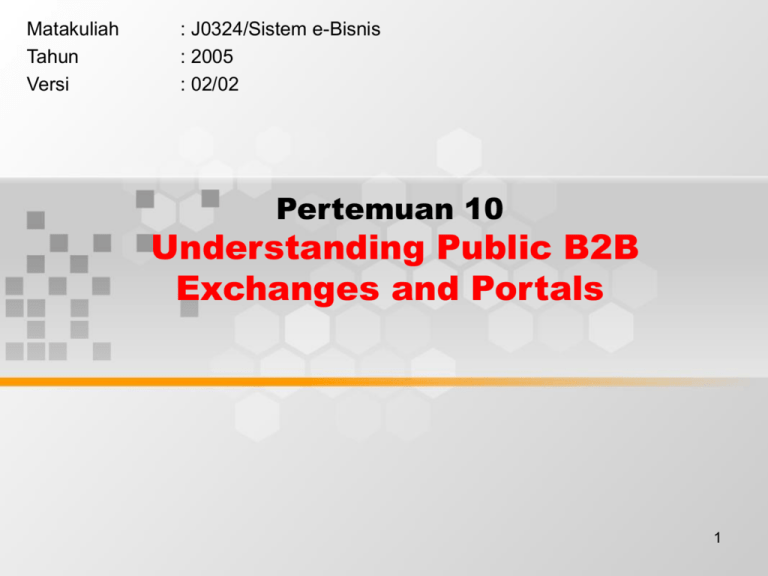
Matakuliah Tahun Versi : J0324/Sistem e-Bisnis : 2005 : 02/02 Pertemuan 10 Understanding Public B2B Exchanges and Portals 1 Learning Outcomes Pada akhir pertemuan ini, diharapkan mahasiswa akan mampu : • menguraikan konsep dan aplikasi portal pertukaran informasi B2B 2 Outline Materi • • • • B2B Electronic Exchanges – An Overview B2B Portals Third Party (Trading) Exchanges Consortium Trading Exchanges 3 B2B Portals • B2B portals: Information portals for businesses • Pure information portals include: – directories of products offered by each seller – lists of buyers and what they want – other industry or general information 4 B2B Portal Examples • Thomas Register—information portal – Sellers distribute information on what they have to sell – Buyers can find what they need and purchase over a comprehensive and secure procurement channel • reduce costs • shrink cycle times • improve productivity 5 B2B Portal Examples (cont.) • Alibaba.com—started as a pure information portal and is moving toward becoming a trading exchange – Huge database is a horizontal information portal with offerings in a wide variety of product categories – Reverse auctions – Features–free email, email alerts, etc – Revenue model—advertisement and fees for special 6 Third Party (Trading) Exchanges • Third-party exchanges are characterized by two contradicting properties – they are neutral, not favoring either sellers or buyers – they do not have a built-in constituency of sellers or buyers and sometimes have a problem attracting enough buyers and sellers to attain financial viability 7 Third Party (Trading) Exchanges (cont.) • A major problem is: Market liquidity: The degree to which something can be bought or sold in a marketplace without affecting its price 8 Third Party (Trading) Exchanges (cont.) 9 Third Party (Trading) Exchanges (cont.) • Buyer aggregation model buyers’ RFQs are aggregated and then linked to a pool of suppliers that are automatically notified of the RFQs • Suitability – aggregation models work best with MROs and services that are well defined, that have stable prices, and where the supplier or buyer base is fragmented 10 Third Party (Trading) Exchanges (cont.) 11 Dynamic Trading: Matching and Auctions • Dynamic trading: Exchange trading that occurs in situations when prices are being determined by supply and demand (e.g., in auctions) • Matching – supply and demand – quantity, delivery times, and locations 12 Dynamic Trading: Matching and Auctions (cont.) • Auctions – Exchanges offer members the ability to conduct auctions or reverse auctions in private trading rooms • auction services as one of its many activities • fully dedicated to auctions – Many-to-many public auctions—vertical, horizontal, run on the Internet or over private lines 13 Building E-Marketplaces • Building e-marketplaces is a complex process – usually performed by a major B2B software company • • • • Commerce One Ariba Oracle IBM 14 Building E-Marketplaces (cont.) • Integration issue – Seamless integration is needed between the third-party exchange and the participants’ front and back-office systems – In private exchanges the seller’s computing system must be integrated with the customers systems 15 Building E-Marketplaces (cont.) – External communications • • • • Web/client access Data exchange Direct application integration Shared procedures – Process and information coordination in integration how to coordinate external communications with internal information systems 16 Building E-Marketplaces (cont.) – Use of Web services in integration Web Services enable different Web-based systems to communicate with each other using Internet-based protocols such as XML – System and information management in integration management of software, hardware, and several information components, including partner-profile information, data and process definitions, communications and security settings, and users’ information 17 Support Services for Public and Private Marketplaces • Directory services and search engines – Directory services help buyers and sellers manage the task of finding potential partners 18 Support Services for Public and Private Marketplaces (cont.) • Partner relationship management (PRM): Business strategy that focuses on providing comprehensive quality service to business partners • E-communities and PRM B2B application needs to provide community services such as chat rooms, bulletin boards, and possibly personalized Web pages 19 Support Services for Public and Private Marketplaces (cont.) • Integration (as per Keenan Report) – Business-to-exchange (B2X) hubs connect all of the Internet business services • • • • • e-merchant services exchange infrastructure buying and selling member enterprises other B2X exchanges 20 Implementation Issues • Private vs. public exchanges Private exchanges: E-marketplaces that are owned and operated by one company. Also known as company-centric marketplaces 21 Implementation Issues (cont.) • Problems with private exchanges – Transaction fees—required to pay transaction fees with existing customers – Sharing information—do not want to share business data with competitors – Cost savings—not great enough to attract buyers – Recruiting suppliers—lose direct contact with customers – Too many exchanges 22 Implementation Issues (cont.) • Supply chain improvers – Companies want to streamline their internal supply chains, which requires integration with internal operations instead of “plugging in” to an exchange’s infrastructure • Major problem is trust in the large corporation running the exchange 23 Implementation Issues (cont.) • Software agents in B2B enable customized syndication of content and services from multiple sources on the Internet to any device connected to the Internet – provide real-time, tighter integration between buyers and sellers – facilitate management of multiple trading partners and their transactions across multiple virtual industry exchanges 24 Example: Asite • Asite’s B2B marketplace for the construction industry – B2B e-marketplace for the construction industry in the United Kingdom – This industry is typified by a high degree of physical separation and fragmentation, and communication among the members of the supply chain is a primary problem 25 Asite (cont.) – Two of the major advantages of the Internet: • ability it provides to communicate more effectively • increased processing power made possible by Internet technologies – Asite decided not to build its own technology, but to establish partnerships with technology vendors that have highly specialized products 26 Asite (cont.) • Commerce One provides the business solution for the portal • Microsoft provides the technology platform and core applications • Attenda is the designer and manager of the Internet infrastructure – Asite is committed to strong partnerships that allow it to seamlessly interact with other emarketplaces 27 Asite (cont.) – Internet browser is all that is needed to connect to Asite’s portal – Ease of access makes it particularly well suited to an industry such as construction • Construction firms streamline their supply chains 28 Asite (cont.) 29 • Source : Turban, Efraim, David King, Jae Lee and Dennis Viehland. Electronic Commerce. A Managerial Perspective (2004). Prentice Hall. PPT for Chapter :7 30

